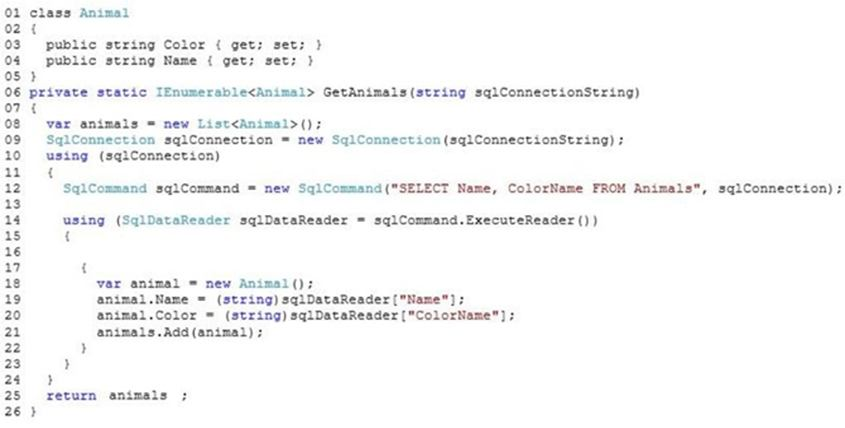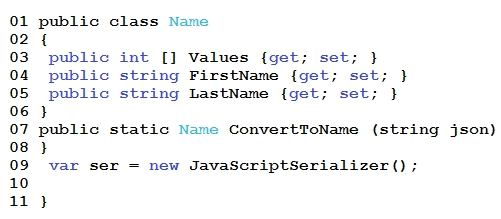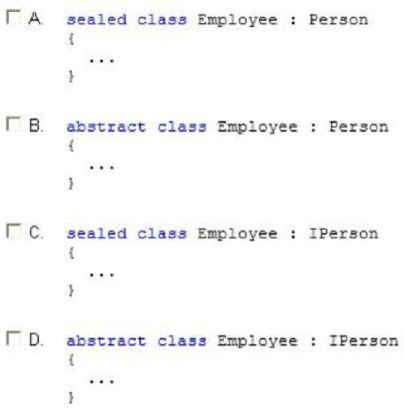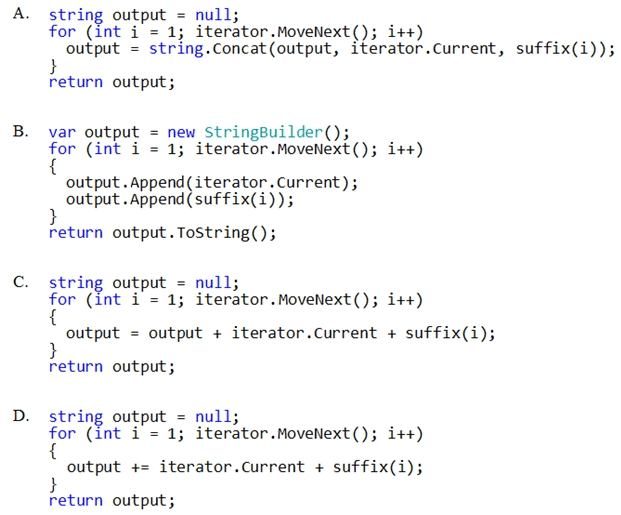Download Programming in C#.70-483.ActualTests.2020-03-26.165q.vcex
| Vendor: | Microsoft |
| Exam Code: | 70-483 |
| Exam Name: | Programming in C# |
| Date: | Mar 26, 2020 |
| File Size: | 17 MB |
How to open VCEX files?
Files with VCEX extension can be opened by ProfExam Simulator.
Discount: 20%
Demo Questions
Question 1
You are developing an application that includes a class named Order. The application will store a collection of Order objects.
The collection must meet the following requirements:
- Use strongly typed members.
- Process Order objects in first-in-first-out order.
- Store values for each Order object.
- Use zero-based indices.
You need to use a collection type that meets the requirements.
Which collection type should you use?
- Queue<T>
- SortedList
- LinkedList<T>
- HashTable
- Array<T>
Correct answer: A
Explanation:
Queues are useful for storing messages in the order they were received for sequential processing. Objects stored in a Queue<T> are inserted at one end and removed from the other. References: http://msdn.microsoft.com/en-us/library/7977ey2c.aspx Queues are useful for storing messages in the order they were received for sequential processing. Objects stored in a Queue<T> are inserted at one end and removed from the other.
References: http://msdn.microsoft.com/en-us/library/7977ey2c.aspx
Question 2
You are developing an application. The application calls a method that returns an array of integers named employeeIds. You define an integer variable named employeeIdToRemove and assign a value to it. You declare an array named filteredEmployeeIds.
You have the following requirements:
- Remove duplicate integers from the employeeIds array.
- Sort the array in order from the highest value to the lowest value.
- Remove the integer value stored in the employeeIdToRemove variable from the employeeIds array.
You need to create a LINQ query to meet the requirements.
Which code segment should you use?

- Option A
- Option B
- Option C
- Option D
Correct answer: C
Question 3
You are developing an application that includes the following code segment. (Line numbers are included for reference only.)

The GetAnimals() method must meet the following requirements:
- Connect to a Microsoft SQL Server database.
- Create Animal objects and populate them with data from the database.
- Return a sequence of populated Animal objects.
You need to meet the requirements.
Which two actions should you perform? Each correct answer presents part of the solution.
NOTE: Each correct selection is worth one point.
- Insert the following code segment at line 16:while(sqlDataReader.NextResult())
- Insert the following code segment at line 13:sqlConnection.Open();
- Insert the following code segment at line 13:sqlConnection.BeginTransaction();
- Insert the following code segment at line 16:while(sqlDataReader.Read())
- Insert the following code segment at line 16:while(sqlDataReader.GetValues())
Correct answer: BD
Explanation:
SqlConnection.Open - Opens a database connection with the property settings specified by the ConnectionString. SqlDataReader.Read - Advances the SqlDataReader to the next record. References:http://msdn.microsoft.com/en-us/library/system.data.sqlclient.sqlconnection.open.aspxhttp://msdn.microsoft.com/en-us/library/system.data.sqlclient.sqldatareader.read.aspx - SqlConnection.Open - Opens a database connection with the property settings specified by the ConnectionString.
- SqlDataReader.Read - Advances the SqlDataReader to the next record.
References:
http://msdn.microsoft.com/en-us/library/system.data.sqlclient.sqlconnection.open.aspx
http://msdn.microsoft.com/en-us/library/system.data.sqlclient.sqldatareader.read.aspx
Question 4
You have an assembly named Assembly1 that is written in C#. Assembly1 has a method named Method1.
You add a new method named Method2 to Assembly1. Method2 is a newer version of Method1 and must be used by applications in the future.
You need to ensure that if a developer builds a project that uses Method1, the developer is notified that Method1 is deprecated.
What should you do?
- Set an #if DEPRECATED preprocessor directive above Method1. Set a #endif preprocessor directive after Method1.
- Set a #pragma warning disable preprocessor inside of Method1.
- Set a #define preprocessor directive above Method1. Set an #if preprocessor directive inside of Method1.
- Set a #warning preprocessor directive inside of Method1.
Correct answer: C
Explanation:
You use #define to define a symbol. When you use the symbol as the expression that's passed to the #if directive, the expression will evaluate to true. Example:#define DEBUG using System; public class TestDefine { static void Main() { #if (DEBUG) Console.WriteLine("Debugging is enabled."); #endif Reference:https://docs.microsoft.com/en-us/dotnet/csharp/language-reference/preprocessor-directives/preprocessor-define You use #define to define a symbol. When you use the symbol as the expression that's passed to the #if directive, the expression will evaluate to true.
Example:
#define DEBUG
using System;
public class TestDefine
{
static void Main()
{
#if (DEBUG)
Console.WriteLine("Debugging is enabled.");
#endif
Reference:
https://docs.microsoft.com/en-us/dotnet/csharp/language-reference/preprocessor-directives/preprocessor-define
Question 5
You are developing an application. The application includes a method named ReadFile that reads data from a file.
The ReadFile() method must meet the following requirements:
- It must not make changes to the data file.
- It must allow other processes to access the data file.
- It must not throw an exception if the application attempts to open a data file that does not exist.
You need to implement the ReadFile() method.
Which code segment should you use?
- var fs = File.Open(Filename, FileMode.OpenOrCreate, FileAccess.Read,FileShare.ReadWrite);
- var fs = File.Open(Filename, FileMode.Open, FileAccess.Read,FileShare.ReadWrite);
- var fs = File.Open(Filename, FileMode.OpenOrCreate, FileAccess.Read,FileShare.Write);
- var fs = File.ReadAllLines(Filename);
- var fs = File.ReadAllBytes(Filename);
Correct answer: A
Explanation:
FileMode.OpenOrCreate - Specifies that the operating system should open a file if it exists; otherwise, a new file should be created. If the file is opened with FileAccess.Read, FileIOPermissionAccess.Read permission is required. If the file access is FileAccess.Write, FileIOPermissionAccess.Write permission is required. If the file is opened with FileAccess.ReadWrite, both FileIOPermissionAccess.Read and FileIOPermissionAccess.Write permissions are required. FileShare.ReadWrite - Allows subsequent opening of the file for reading or writing. If this flag is not specified, any request to open the file for reading or writing (by this process or another process) will fail until the file is closed. However, even if this flag is specified, additional permissions might still be needed to access the file. References: http://msdn.microsoft.com/pl-pl/library/system.io.fileshare.aspxhttp://msdn.microsoft.com/en-us/library/system.io.filemode.aspx FileMode.OpenOrCreate - Specifies that the operating system should open a file if it exists; otherwise, a new file should be created. If the file is opened with FileAccess.Read, FileIOPermissionAccess.Read permission is required. If the file access is FileAccess.Write, FileIOPermissionAccess.Write permission is required. If the file is opened with FileAccess.ReadWrite, both FileIOPermissionAccess.Read and FileIOPermissionAccess.Write permissions are required.
FileShare.ReadWrite - Allows subsequent opening of the file for reading or writing. If this flag is not specified, any request to open the file for reading or writing (by this process or another process) will fail until the file is closed. However, even if this flag is specified, additional permissions might still be needed to access the file.
References:
http://msdn.microsoft.com/pl-pl/library/system.io.fileshare.aspx
http://msdn.microsoft.com/en-us/library/system.io.filemode.aspx
Question 6
An application receives JSON data in the following format:

The application includes the following code segment. (Line numbers are included for reference only.)

You need to ensure that the ConvertToName() method returns the JSON input string as a Name object.
Which code segment should you insert at line 10?
- Return ser.ConvertToType<Name>(json);
- Return ser.DeserializeObject(json);
- Return ser.Deserialize<Name>(json);
- Return (Name)ser.Serialize(json);
Correct answer: C
Explanation:
JavaScriptSerializer.Deserialize<T> - Converts the specified JSON string to an object of type T. References: http://msdn.microsoft.com/en-us/library/bb355316.aspx JavaScriptSerializer.Deserialize<T> - Converts the specified JSON string to an object of type T.
References: http://msdn.microsoft.com/en-us/library/bb355316.aspx
Question 7
You are developing an application. The application converts a Location object to a string by using a method named WriteObject. The WriteObject() method accepts two parameters, a Location object and an XmlObjectSerializer object.
The application includes the following code. (Line numbers are included for reference only.)

You need to serialize the Location object as a JSON object.
Which code segment should you insert at line 20?
- New DataContractSerializer(typeof(Location))
- New XmlSerializer(typeof(Location))
- New NetDataContractSerializer()
- New DataContractJsonSerializer(typeof(Location))
Correct answer: D
Explanation:
The DataContractJsonSerializer class serializes objects to the JavaScript Object Notation (JSON) and deserializes JSON data to objects. Use the DataContractJsonSerializer class to serialize instances of a type into a JSON document and to deserialize a JSON document into an instance of a type. The DataContractJsonSerializer class serializes objects to the JavaScript Object Notation (JSON) and deserializes JSON data to objects.
Use the DataContractJsonSerializer class to serialize instances of a type into a JSON document and to deserialize a JSON document into an instance of a type.
Question 8
You are developing an application. The application includes classes named Employee and Person and an interface named IPerson.
The Employee class must meet the following requirements:
- It must either inherit from the Person class or implement the IPerson interface.
- It must be inheritable by other classes in the application.
You need to ensure that the Employee class meets the requirements.
Which two code segments can you use to achieve this goal? (Each correct answer presents a complete solution. Choose two.)

- Option A
- Option B
- Option C
- Option D
Correct answer: BD
Explanation:
Sealed - When applied to a class, the sealed modifier prevents other classes from inheriting from it. References: http://msdn.microsoft.com/en-us/library/88c54tsw(v=vs.110).aspx Sealed - When applied to a class, the sealed modifier prevents other classes from inheriting from it.
References: http://msdn.microsoft.com/en-us/library/88c54tsw(v=vs.110).aspx
Question 9
You are developing an application that will convert data into multiple output formats.
The application includes the following code. (Line numbers are included for reference only.)

You are developing a code segment that will produce tab-delimited output. All output routines implement the following interface:

You need to minimize the completion time of the GetOutput() method.
Which code segment should you insert at line 06?

- Option A
- Option B
- Option C
- Option D
Correct answer: B
Explanation:
A String object concatenation operation always creates a new object from the existing string and the new data. A StringBuilder object maintains a buffer to accommodate the concatenation of new data. New data is appended to the buffer if room is available; otherwise, a new, larger buffer is allocated, data from the original buffer is copied to the new buffer, and the new data is then appended to the new buffer. The performance of a concatenation operation for a String or StringBuilder object depends on the frequency of memory allocations. A String concatenation operation always allocates memory, whereas a StringBuilder concatenation operation allocates memory only if the StringBuilder object buffer is too small to accommodate the new data. Use the String class if you are concatenating a fixed number of String objects. In that case, the compiler may even combine individual concatenation operations into a single operation. Use a StringBuilder object if you are concatenating an arbitrary number of strings; for example, if you're using a loop to concatenate a random number of strings of user input. References: http://msdn.microsoft.com/en-us/library/system.text.stringbuilder(v=vs.110).aspx A String object concatenation operation always creates a new object from the existing string and the new data.
A StringBuilder object maintains a buffer to accommodate the concatenation of new data. New data is appended to the buffer if room is available; otherwise, a new, larger buffer is allocated, data from the original buffer is copied to the new buffer, and the new data is then appended to the new buffer.
The performance of a concatenation operation for a String or StringBuilder object depends on the frequency of memory allocations. A String concatenation operation always allocates memory, whereas a StringBuilder concatenation operation allocates memory only if the StringBuilder object buffer is too small to accommodate the new data. Use the String class if you are concatenating a fixed number of String objects. In that case, the compiler may even combine individual concatenation operations into a single operation. Use a StringBuilder object if you are concatenating an arbitrary number of strings; for example, if you're using a loop to concatenate a random number of strings of user input.
References: http://msdn.microsoft.com/en-us/library/system.text.stringbuilder(v=vs.110).aspx
Question 10
You are developing an application by using C#.
The application includes an object that performs a long running process.
You need to ensure that the garbage collector does not release the object's resources until the process completes.
Which garbage collector method should you use?
- ReRegisterForFinalize()
- SuppressFinalize()
- Collect()
- WaitForFullGCApproach()
Correct answer: B
HOW TO OPEN VCE FILES
Use VCE Exam Simulator to open VCE files

HOW TO OPEN VCEX AND EXAM FILES
Use ProfExam Simulator to open VCEX and EXAM files


ProfExam at a 20% markdown
You have the opportunity to purchase ProfExam at a 20% reduced price
Get Now!



